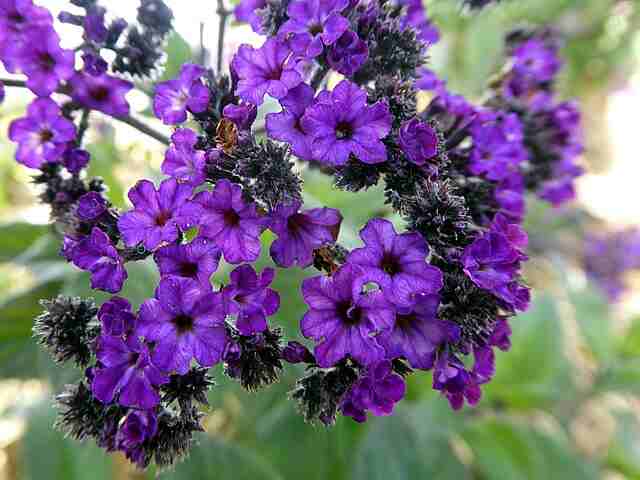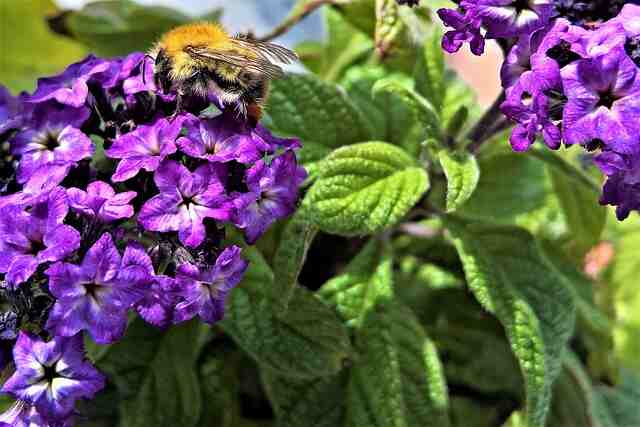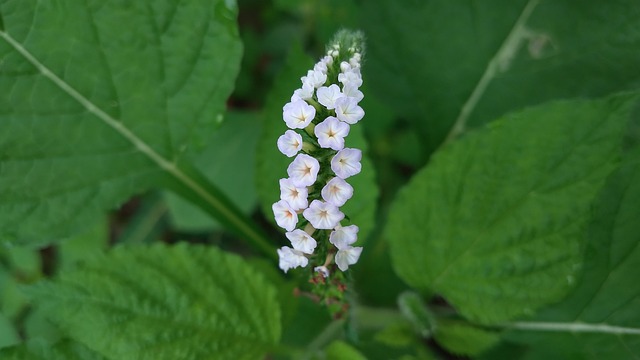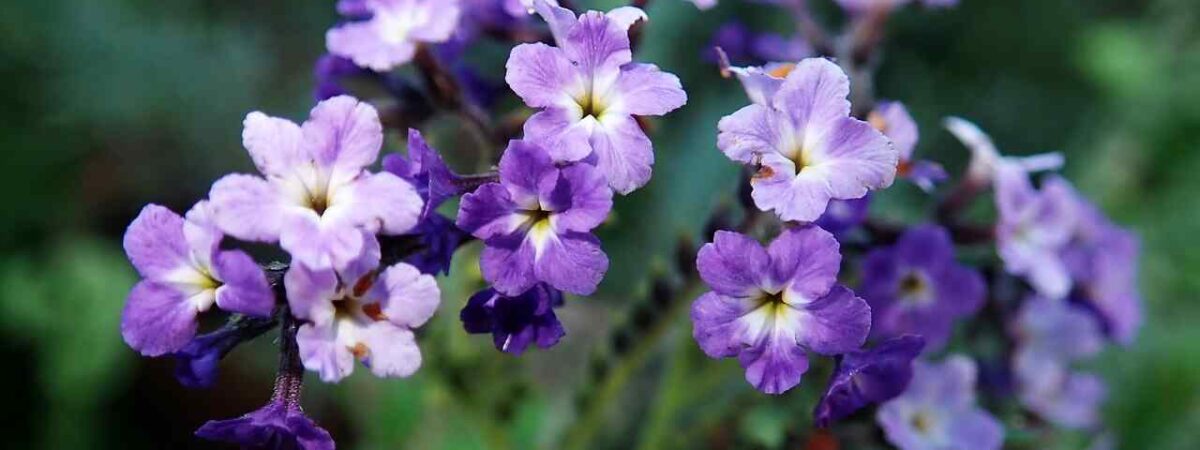Are you looking to add some vibrant colors and sweet fragrances to your garden?
Look no further than the charming heliotrope!
With its clusters of tiny purple or white flowers and vanilla-like scent, this plant is a favorite among gardeners.
But how can you ensure your heliotrope thrives and stays healthy?
In this post, we’ll share tips on everything from planting to pruning, so you can grow and care for your heliotrope like a pro. Let’s get started!
Plant overview
Heliotrope (Heliotropium arborescens) is a perennial flowering plant native to Peru that is widely cultivated for its fragrant clusters of small flowers. The plant grows up to 2-3 feet tall and has dark green, slightly hairy leaves that are 2-4 inches long. The flowers are typically purple or white and bloom from mid-summer to early fall. The plant is known for its sweet vanilla-like scent, which is most pronounced in the evening when the flowers open.
It is a popular plant for gardens, patios, and balconies due to its colorful flowers and intoxicating fragrance. It is often used in borders, mass plantings, and container gardens. The plant prefers well-drained soil and full sun to partial shade. It can tolerate some drought and heat, but it does not do well in extreme temperatures.
Heliotrope has been used for medicinal purposes in some cultures, although it should be noted that the plant can be toxic if ingested. Overall, It is a beautiful and fragrant addition to any garden or outdoor space.
Benefits of growing heliotrope

Growing heliotrope offers a range of benefits, both aesthetic and practical. Here are some of the key advantages of adding this beautiful plant to your garden:
Beautiful and Fragrant Blooms
Heliotrope is prized for its lovely clusters of small, delicate flowers, which come in shades of purple, blue, and white. The flowers also emit a sweet, vanilla-like scent that is particularly strong in the evening, making it a popular choice for evening gardens and patios.
Low Maintenance
It is a hardy plant that requires little maintenance, aside from regular watering and fertilization. It is also relatively pest-resistant and can tolerate some drought and heat.
Attracts Pollinators
Heliotrope flowers are a source of nectar for bees, butterflies, and other pollinators, making it a valuable addition to any pollinator garden.
Medicinal Properties
In some cultures, It has been used for medicinal purposes, such as treating coughs, colds, and inflammation. However, it should be noted that the plant can be toxic if ingested, so it should be used with caution.
Long Blooming Season
Heliotrope blooms from mid-summer to early fall, providing a long-lasting source of color and fragrance in your garden.
Overall, growing it is a great way to add beauty and fragrance to your outdoor space, while also supporting pollinators and potentially even providing medicinal benefits.
How to plant a heliotrope?
Best time and location for planting
The best time to plant heliotrope is in the spring after the danger of frost has passed, or in the fall before the first frost. This allows the plant to establish its root system before the hot summer months or the harsh winter weather.
As for location, it prefers full sun to partial shade and well-drained soil. It can be planted in garden beds, borders, or containers, as long as it receives enough sunlight and is not exposed to extreme temperatures or moisture. Heliotrope is also a good option for adding color and fragrance to balcony gardens or patio planters.
Steps for planting heliotrope
Here are the steps for planting heliotrope:
- Choose a location that receives at least six hours of direct sunlight each day. Heliotropes prefer well-draining soil and can tolerate some dryness, but they also need consistent moisture.
- Prepare the soil by adding compost or other organic matter to improve the soil’s fertility and drainage. It also prefers slightly acidic soil with a pH between 6.0 and 7.0.
- Dig a hole that is twice the size of the root ball of a heliotrope. Remove your plant from its container and try gently loosening the roots.
- Place the plant in the hole, making sure that the top of the root ball is level with the surrounding soil. Backfill the hole where you have planted the rootball with soil and gently firm it down around the plant.
- Water the plant thoroughly after planting and continue to water it regularly, keeping the soil moist but not waterlogged.
- Mulch around the plant with a layer of organic material, such as shredded leaves or bark chips, to help retain moisture and suppress weeds.
- Fertilize the heliotrope once a month during the growing season with a balanced fertilizer.
- Deadhead spent flowers regularly to encourage the plant to produce more blooms.
- Enjoy the beauty and fragrance of your plant throughout the growing season!
How to care for a heliotrope?

Soil
Heliotropes prefer well-draining soil that is rich in organic matter. They can tolerate a wide range of soil types, including sandy or loamy soil, but it is important that the soil does not become waterlogged or too dry. It prefers slightly acidic soil with a pH between 6.0 and 7.0.
To prepare the soil for planting, you can add compost or other organic matter to improve fertility and drainage. It is also important to water heliotropes regularly to maintain consistent moisture levels in the soil. Overall, these are relatively adaptable plants when it comes to soil requirements.
Water
Heliotropes require regular watering to maintain consistent moisture levels in the soil. They prefer soil that is moist but not waterlogged and can tolerate some dryness. When planting these, it is important to water the plant thoroughly after planting and to continue watering regularly, especially during dry periods.
It is also important to avoid overwatering, as this can lead to root rot and other problems. Heliotropes in containers may require more frequent watering than those in the ground, as containers tend to dry out more quickly. Overall, it is important to keep the soil around this plant consistently moist, without allowing it to become waterlogged.
Light
Heliotropes require at least six hours of direct sunlight each day to thrive. They can tolerate some shade, but full sun is preferable for optimal growth and blooming. If grown in areas with intense sunlight or high temperatures, heliotropes may benefit from some protection during the hottest part of the day.
When planting heliotropes, it is important to choose a location that receives adequate sunlight and to avoid planting in areas with too much shade. Overall, providing heliotropes with enough sunlight is crucial to their growth and flowering, so it is important to choose a location that can provide them with enough sun exposure.
Temperature
Heliotropes are annuals or perennials that thrive in moderate temperatures, but they can tolerate a range of temperatures. They prefer temperatures between 60 and 75 degrees Fahrenheit, and may require some protection from intense heat.
In areas with high temperatures or intense sunlight, heliotropes may benefit from some shade or protection during the hottest part of the day. In cooler climates, heliotropes may require protection from frost or freezing temperatures.
Overall, heliotropes can tolerate a range of temperatures but they grow best in moderate temperatures, so it is important to choose a location that provides them with appropriate temperature conditions for optimal growth and blooming.
Humidity
Heliotropes prefer moderate to high humidity levels to thrive, but they can also tolerate lower humidity levels. They are native to areas with high humidity, so providing some humidity can help them grow and bloom better. In dry climates, heliotropes may benefit from occasional misting or placing a tray of water near them to increase humidity levels.
It is also important to avoid overwatering heliotropes, as this can lead to excess moisture and increase the risk of fungal diseases. Overall, providing moderate to high humidity levels can help heliotropes grow and bloom better, but they can tolerate a range of humidity levels.
Fertilizer
Heliotropes benefit from regular fertilization to promote healthy growth and blooming. It is recommended to fertilize them once a month during the growing season, using a balanced fertilizer with equal amounts of nitrogen, phosphorus, and potassium.
Over-fertilization can lead to excessive growth and fewer blooms, so it is important to follow the instructions on the fertilizer package and avoid overuse. It is also important to avoid fertilizing heliotropes during the dormant season or when they are stressed, as this can damage the plant.
Overall, providing regular and moderate fertilization can help heliotropes grow and bloom better, while avoiding overuse or fertilizing during the wrong time.
How to prune a heliotrope?
To prune a heliotrope, follow these steps:
- Wait until your plant has finished blooming.
- Use clean, sharp pruning shears to make your cuts.
- Cut back the stems by about one-third to one-half of their length.
- Make each cut just above a leaf node or branching point.
- Remove any dead, diseased, or damaged stems.
- Thin out all the crowded or crossed branches to improve air circulation and light penetration.
- Shape the plant to your desired size and form.
- Water your heliotrope plant thoroughly after pruning to help it recover.
How to propagate a heliotrope?
Heliotrope can be propagated through stem cuttings, which is a simple and effective way to create new plants. Here are the steps to propagate a heliotrope:
- Choose a healthy heliotrope plant and identify a stem that is about 4-6 inches long and has several leaves.
- Use a clean, sharp knife or shears to make a clean cut just below a leaf node.
- Remove the lower leaves from the stem of your plant and leave only the top few leaves intact.
- Dip the cut end of the stem in some rooting hormone powder and encourage its root growth.
- Prepare a pot with moist potting soil and create a hole in the center with a pencil or finger.
- Insert the stem cutting into the hole and gently press the soil around it to ensure good contact.
- Water the soil to moisten it, and cover the pot with a plastic bag to create a humid environment for the cutting.
- Place the pot in a warm, bright spot, but avoid direct sunlight.
- Keep the soil moist, but not too wet, and mist the cutting occasionally to maintain humidity.
- After about four to six weeks, the cutting should have developed roots and can be transplanted to a larger pot or outdoors.
Common pests and diseases

Like any plant, heliotrope is susceptible to various pests and diseases. Here are some of the most common ones to watch out for:
Spider mites
These tiny pests can cause leaves to yellow and develop a fine webbing. Regularly inspect your plants and treat with insecticidal soap or neem oil.
Aphids
These soft-bodied insects can distort leaves and cause stunted growth. Spray plants with a strong jet of water to knock them off, or use insecticidal soap.
Whiteflies
These small, winged insects suck sap from the leaves and can cause yellowing and wilting. Sticky traps or insecticidal soap can help control their numbers.
Powdery mildew
A fungal disease that creates a white, powdery coating on leaves, which can stunt growth and reduce flowering. Improve air circulation and remove infected leaves. Fungicides can also be used.
Root rot
This can be caused by overwatering or poor drainage, and can lead to wilting, yellowing, and root decay. Ensure proper drainage and reduce watering.
Leaf spot
This fungal disease causes circular spots on leaves that turn yellow and then brown. Remove infected leaves and improve air circulation.
Preventing pests and diseases through good cultural practices like proper watering, fertilizing, and pruning can help keep your heliotrope healthy and vibrant.
Conclusion
Heliotrope is a beautiful and fragrant plant that can add color and interest to any garden or indoor space. To grow and care for heliotrope, it’s important to provide it with the right conditions, including well-draining soil, adequate sunlight, and regular watering and fertilizing.
Pruning and deadheading can also help promote healthy growth and abundant flowering. Being aware of common pests and diseases and taking preventative measures can also ensure that your heliotrope stays healthy and vibrant. With a little care and attention, you can enjoy the beauty and fragrance of heliotrope for years to come.
You may also like to read
How to Grow and Care for Calla Lilies: A Comprehensive Guide






